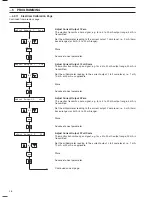
35
8
MAINTENANCE
8.4.2
Monitor Diagnostic Information
Out of Service Alarm
This alarm relay output is a normally energised relay which de-
energises in the following circumstances:
a) Loss of mains supply.
b) Calibration Failed – the calculated electrode slope value is
outside the acceptable limits or the response of the probe
is too slow. The 'CAL FAIL' l.e.d. on the front panel is
illuminated with the appropriate text on the 20-character
display.
c)
Block temperature out of limits – the measured
temperature of the Block is not within 5
°
C of the Control
Temperature. 'TEMP. CONTROL ERROR' is indicated on
the 20-character display.
d)
'OUT OF SAMPLE' alarm – a float switch in the
constant head unit detects the loss of sample. 'OUT OF
SAMPLE' is indicated on the 20-character display.
e) 'OUT OF SERVICE' alarm – displayed when the pump is
switched off.
Note.
The heater is switched off by the software when an
'OUT OF SAMPLE' condition is detected.
Calibration Fail Alarm
A calibration failed condition occurs after a two point
calibration if the calculated slope value is less than 80% or if
the probe output is unstable. The failure could be caused by a
number of factors which should be investigated.
In the 'CAL. FAILED (SLOPE)' case some indication of the
problem may be obtained from the slope value.
Slope Value Just Below 80%
a) Check liquid delivery on to the probe membrane – see
Section 8.2.7 (j).
b) Clean membrane by washing with a jet of clean water from
a wash–bottle or syringe.
c) Disassemble probe and reassemble – see Section 8.2.7.
d) Check glass electrode – see Section 8.5.
Slope Value Grossly Abnormal
a) Check, and top up as necessary, the filling solution in the
probe. There should be a 50 to 60 mm depth of solution
inside the probe.
b) Disassemble probe and reassemble – see Section 8.2.7.
c) Check glass electrode – see Section 8.5.
d) Check reference element – see Section 8.5.
Noisy, unstable response or slow response
a) Check liquid delivery on to the probe membrane – see
Section 8.2.7 (j).
b) Clean membrane by washing with a jet of clean water from
a wash–bottle or syringe.
c) Check, and top up as necessary, the filling solution in the
probe. There should be a 50 to 60 mm depth inside the
probe so that the reference element is immersed in the
solution.
d) Osmotic effects, i.e. total concentration of dissolved
species in samples too high.
e) Puncture of the membrane (usually visible), disassemble
probe and reassemble – see Section 8.2.7.
f)
Interference (from for example high concentrations of
anionic detergents).
g) Check glass electrode – see Section 8.5.
h) Check reference element – see Section 8.5.
In the 'CAL. FAILED (SLOW)' case the failure is usually due to
slow sensor response, but may be due to an unstable (noisy or
drifting) sensor output:
a) Check sensor connections in the coaxial plugs and
sockets, and inside the microprocessor unit.
b) See
Malfunction of the Electrode/Probe
– see Section
8.4.3.
8.4.3
Malfunction of the Probe
Internal Filling Solution
The internal filling solution incorporates a coloured indicator
which is normally yellow. The indicator changes to blue if the
probe membrane, or membrane seal, allows alkaline reagent
to leak into the probe. If this occurs the membrane should be
replaced, and care taken to tighten the end cap sufficiently to
provide a good seal. The solution keeps indefinitely.
8.5
General Maintenance of the Probe
8.5.1
Ageing of the Glass Electrode
After the probe has been in use for some months, the
performance of the glass electrode may eventually deteriorate
due to its continued use in weakly buffered solutions at near
neutral pH. The response of the probe becomes sluggish and
the response slope drops. The electrode may frequently be
restored to its initial condition by soaking for 12 hours in 0.1M
hydrochloric acid. The performance of the electrode may be
checked as described below.
8.5.2
Checking the Performance of the Glass
Electrode
The glass electrode may be checked independently of the
probe with a laboratory calomel reference electrode by testing
the pair in pH buffer solutions.
Immerse the glass electrode to a depth of 5 to 10 mm. There
must be no liquid contact with the reference element.








































